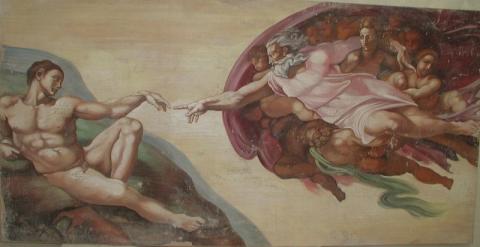Michelangelo
Michelangelo
Above: Our reproduction (in picture) of the creation of Adam by Michelangelo
Florence was not only the cradle of the Renaissance, but also that of Michelangelo’s genius. It is in this city that the Italian master was first influenced by the works of artists such as Masaccio and Giotto: it was by painstakingly copying their paintings that Michelangelo trained his young hand, at the beginning of his artistic career. In today’s world, we would call Michelangelo a difficult teenager: he decided to quit school against his father’s wish, and joined the art studio of one of the most respected artists of the time, il Ghirlandaio, who was famed for his talent as a fresco painter.
Faithful to the tag we gave him above, Michelangelo decided to quit Ghirlandaio’s studio after a mere 12 months, opting to focus on sculpture instead. He learnt the basics by observing the perfect plasticity of the ancient works orderly placed in the beautiful gardens of the Medici’s family: soon, Lorenzo De’ Medici understood the young man was immensely talented and opened the doors of his home to Michelangelo, as if he “were a son”.
Following the death of Lorenzo De’ Medici, in 1402, his son Piero succeeded him. Piero was unable to contain the increasing influence of the monk Girolamo Savonarola and his followers on the social and political arena of the city. Savonarola and his people were also strongly critical, among other things, to the prevailing artistic styles of the time.
How different Piero was from his father: the strength and charisma of the latter were entirely absent from the former, who was also incapable to halt the invasion of the French troops of Charles VIII in 1494. Piero was eventually deposed by an insurrection of the Florentines, who had had enough of his weakness. During this period of uncertainty Michelangelo, who was barely nineteen, left Florence, traveling first to Bologna, then to Rome where he was to spend most of his life. Just as today, Rome was a coffer full of incredible artistic treasures, and it was an ideal place of study for Michelangelo, who kept his focus on sculpture. His first two works, the Bacco Ebbro (Drunken Bacchus), and a moving Pietà (Deposition) were a tribute to the dual cultural identity of Rome, pagan and Christian, Roman and Papal.
Because of its form, composition and emotional content, to this day the Pietà, commissioned in 1498, is considered the most beautiful marble sculpture of Rome and among the most sublime statues of the world: we are talking, in case you were wondering about the Pietà Vaticana, the one you can see in St Peter’s Basilica.
Michelangelo sculpted it when he was barely 20 years old.
In 1508 Michelangelo was still considering himself mostly a sculptor, but signed nevertheless a contract offered by Pope Giulio II, to take up the duty of frescoing the vault ceiling of the Cappella Sistina in the Vatican. Michelangelo immersed himself into this project, which he mostly completed alone, without the help of any apprentice. He, in fact, expanded the project beyond the representation of the 12 apostles originally envisaged, to more than 300 figures.
Michelangelo learned fresco techniques with his first master, Ghirlandaio, in Florence. His talent, obvious to us all just by looking at his work, became, if needed, even more clear after the Cappella Sistina restoration works of the 1990’s, which demonstrated how he truly reached the highest peaks of perfection in this form of art.
Frescoing requires the artist to paint a freshly plastered wall, while it is still humid. This is necessary for pigments to bond with the plaster and become one with the wall and render the painting resistant. In order to paint the plaster, which dries very quickly, the artist must be very fast and precise and he must know clearly how much he can paint during the course of the day (giornata).
During the restoration process, specialists have been able to identify how much Michelangelo would paint in a day of work, by observing the plaster boarders of each section of the fresco. From these, it is clear that Michelangelo painted at a remarkably high speed, on a daily basis: he completed this immense monumental work of art in only four years, between 1508 and 1512.
The 1990’s restoration of the Cappella Sistina became necessary because of the amounts of dust and polluting agents that had covered the paintings in the course of the centuries. Degradation was caused by centuries long use of candles and petroleum lamps within the wall of the chapel, but also from the enormous amount of dirt that entered the rooms from the overly polluted Roman streets.
Things would have been, probably, less dramatic if 18th century conservation specialists did not decide to cover all frescoes with a thick layer of what they considered a protective substance which, in fact, only allowed the dirt to stick more to the walls, rendering colors opaque and dull. After the intervention of 1990-1994, the frescoes’ original vivid and clear colors emerged, the magnificence and splendor of Michelangelo’s hand finally brought back to its original glory. Further steps have been taken in recent years to make sure the Cappella Sistina will keep its beauty unspoiled for centuries to come: an air conditioning system has been installed to assure an hourly change of air, and a filtering system has been implemented to clean the air coming from outside the chapel.

